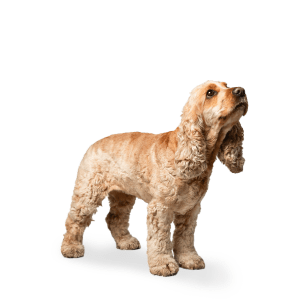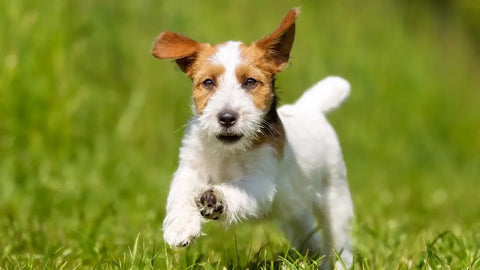

Dog constipation: What do I need to know?
When your dog’s struggling to poop, it’s tempting to reach for a quick fix – but that could make things worse. Constipation isn’t a diagnosis – it’s a symptom. And the cause matters. Before you try anything at home, it’s worth understanding what might be going on.
What is constipation in dogs?
Constipation in dogs – just like in people – means going less often than usual, or struggling to go. Most dog owners know their pup’s toilet routine pretty well (we’re the ones picking it up, after all). But if, like many of us, you sometimes run on autopilot, you might not be completely sure when your dog last went.
As a rule of thumb, younger dogs tend to poop more often. Healthy adult dogs usually go two or three times a day. So if you're curled up with your dog in the evening and realise you don’t remember picking up any poop, don’t panic – but do pay closer attention the next day. A longer morning walk can help get things moving and gives you a chance to check.
Also keep in mind that how much – and what – your dog eats will affect how much they poop. Maybe you’ve switched to a healthier diet and they’re still adjusting (or sulking), or the new food simply results in smaller, neater poops than before. If it’s easy to pass and easy to pick up – a moist log, for example – it’s less likely to be a medical concern. It might just be less poop.
Puppy constipation
In puppies, constipation technically means the same thing – less frequent or difficult pooping – but it can become serious much more quickly. Puppies eat more often to fuel their growth and burn through energy fast. So if they stop eating, even mild constipation can lead to hospitalisation.
In very young puppies, even 6 to 12 hours without a poo can be a red flag. If your pup is off their food, has a bloated tummy, is whining or seems in pain, don’t wait – get them to the vet straight away.
If you’re unsure whether your puppy’s pattern is normal, we’ve got a short blog on how often your puppy should poop – with typical timings for each stage of development.

Symptoms of constipation in dogs
The signs of constipation can vary from dog to dog – and even from one episode to the next in the same dog. That’s because it can be caused by a wide range of things, so what you notice as an owner may differ each time.
Changes in toilet habits
- Pooping less often than normal
- Not passing anything – or only small amounts – at their usual toilet times, such as on a morning walk
Straining to poop
- Taking longer than usual to pass even a small amount
- Adopting the poop position without producing anything
Pain or discomfort
- Signs of pain while passing poop
- Reluctance to posture for toileting at all
Abnormal-looking poop
- Small, hard, dry dog poops
- Straining that results in small drips of liquid
- Blood or mucus in or around the poop
- Ribbon-like or flattened poop
Whole-body signs
- Lethargy or low energy
- Hiding or sitting alone
- Eating less or skipping meals
- Vomiting
- Bloated, tense or firm abdomen
What causes constipation in dogs
Before we get into treatment, let’s look at some of the possible causes. Constipation in dogs can stem from issues inside the intestines, within the intestinal wall, outside the digestive system, or as part of a wider health concern.
Inside the intestines
- Blockage – e.g. a sock, toy or stone
- Indigestible material in poop – bones, hair, sand, grass or matted fur
- Worms
- Low-fibre diet
- Dehydration in dogs – leads to more water being absorbed from poop, making it drier and harder to pass, which can create a vicious cycle
In the wall of the intestines
- Inflammation – such as colitis
- Tumours or growths
- Neuromuscular problems – where the muscle of the gut can’t contract properly
Outside the intestines
- Anal gland impaction or infection
- Prostate enlargement – especially unneutered males
- Hernias or prolapses
Whole-body factors
- Lack of exercise
- Some medications
-
Underlying illness – e.g. kidney disease or diabetes can affect hydration or gut function
- Pain from canine arthritis or injury
Because the causes can be so varied, jumping in with home treatments – however well-intentioned – might delay the right care or even do more harm than good.

How to relieve constipation in dogs
We’ll go through some safe steps you can try at home in the sections below. But if your dog seems unwell, is lethargic, in pain, or hasn’t pooped within 12 to 24 hours of trying those steps, it’s time to see the vet.
After examining your dog and asking about their history, your vet may recommend tests to find out why they’re constipated and how much poop has built up. This might include blood tests, X-rays, an ultrasound, and often intravenous fluids.
Constipation can sometimes be just the tip of the iceberg – and in more serious cases, your dog may need a general anaesthetic to fully and safely empty the colon.
How to make a constipated dog poop quickly
If your dog seems a little backed up, it’s natural to want to help them feel better quickly. The good news is that mild cases often respond well to a few simple management steps. But try to avoid jumping in with home remedies – and definitely steer clear of human medications. They can be dangerous, and most of the time, there’s no need to take that kind of risk.
Some dogs with a history of constipation may have a vet-approved plan in place, including specific laxatives or diet changes to use at the first signs. But that’s the exception, not the rule – and it should always be done with your vet’s guidance.
Natural remedies for constipated dogs
In the first 12 to 24 hours after noticing a problem, if your dog seems bright and otherwise well, a little water and gentle exercise may be all it takes to get things moving safely.
- Water is key to maintaining hydration and softening dry poop, so encourage drinking.
o Do add water to small amounts of their food.
o Don’t give milk – it can cause digestive upset in dogs.
o Don’t give gravy – it’s too salty and may worsen dehydration.
- Regular movement stimulates the digestive tract, and multiple short walks can be more effective than one long one.
Avoid making any sudden or dramatic diet changes while your dog is constipated, unless your vet advises it. Adding fibre might seem like a good idea, but it can sometimes make things worse by creating a larger mass that’s still difficult to pass. Read our guide to the benefits of fibre for dogs.
These simple steps are often enough to help a mildly constipated dog start pooping again. But if there’s no improvement within 12 to 24 hours – or if your dog seems uncomfortable, lethargic or goes off their food – it’s time to contact your vet.
What to feed a constipated dog
During a bout of constipation, it’s safest to stick with the steps from the previous section. But if your dog tends to get constipated often, your vet may recommend the following once things are back to normal:
- A special high-fibre diet
- A fibre supplement
- Long-term hydration strategies
It might have been just a one-off episode, but if you’re looking to support your dog’s long-term digestive health, take a look at our tips for healthy doggy digestion.



